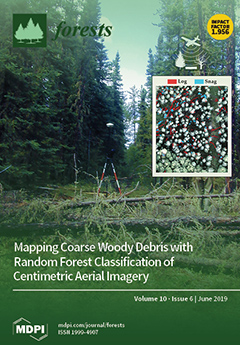Research Highlights: We compared annually resolved records of tree-ring width and stable isotope of dead and surviving
Fokienia hodginsii (Dunn) Henry et Thomas trees. We provide new insights into the relationships and sensitivity of tree growth to past and current climate, and explored the underlying mechanism of drought-induced mortality in
F. hodginsii.
Background and Objectives: Drought-induced tree decline and mortality are increasing in many regions around the world. Despite the high number of studies that have explored drought-induced decline, species-specific responses to drought still makes it difficult to apply general responses to specific species. The endangered conifer species,
Fokienia hodginsii, has experienced multiple drought-induced mortality events in recent years. Our objective was to investigate the historical and current responses to drought of this species.
Materials and Methods: We used annually resolved ring-width and δ
13C chronologies to investigate tree growth and stand physiological responses to climate change and elevated CO
2 concentration (C
a) in both dead and living trees between 1960 and 2015. Leaf intercellular CO
2 concentration (C
i), C
i/C
a and intrinsic water-use efficiency (iWUE) were derived from δ
13C.
Results: δ
13C were positively correlated with mean vapor pressure deficit and PDSI from previous October to current May, while ring widths were more sensitive to climatic conditions from previous June to September. Moreover, the relationships between iWUE, basal area increment (BAI), and C
i/C
a changed over time. From 1960s to early 1980s, BAI and iWUE maintained a constant relationship with increasing atmospheric CO
2 concentration. After the mid-1980s, we observed a decrease in tree growth, increase in the frequency of missing rings, and an unprecedented increase in sensitivity of
13C and radial growth to drought, likely related to increasingly dry conditions.
Conclusions: We show that the recent increase in water stress is likely the main trigger for the unprecedented decline in radial growth and spike in mortality of
F. hodginsii, which may have resulted from diminished carbon fixation and water availability. Given that the drought severity and frequency in the region is expected to increase in the future, our results call for effective mitigation strategies to maintain this endangered tree species.
Full article





